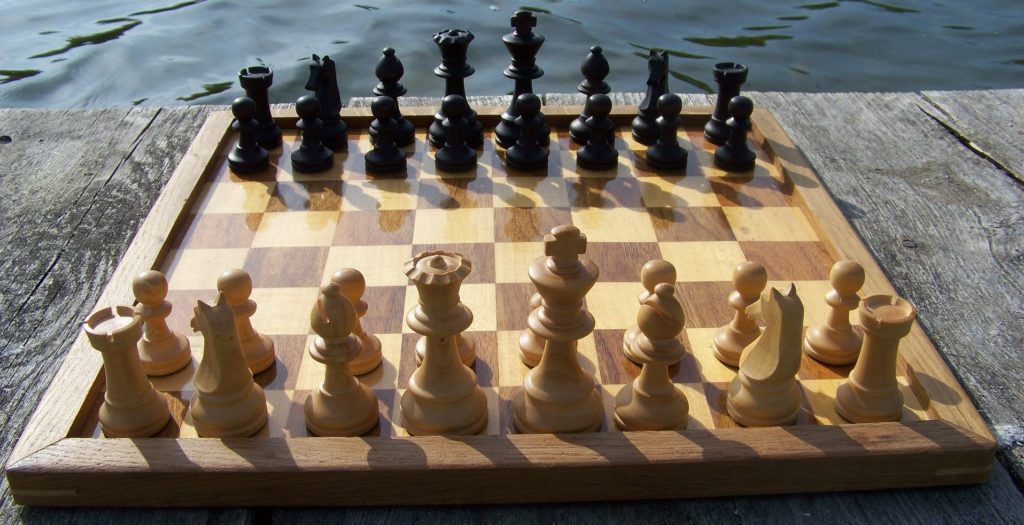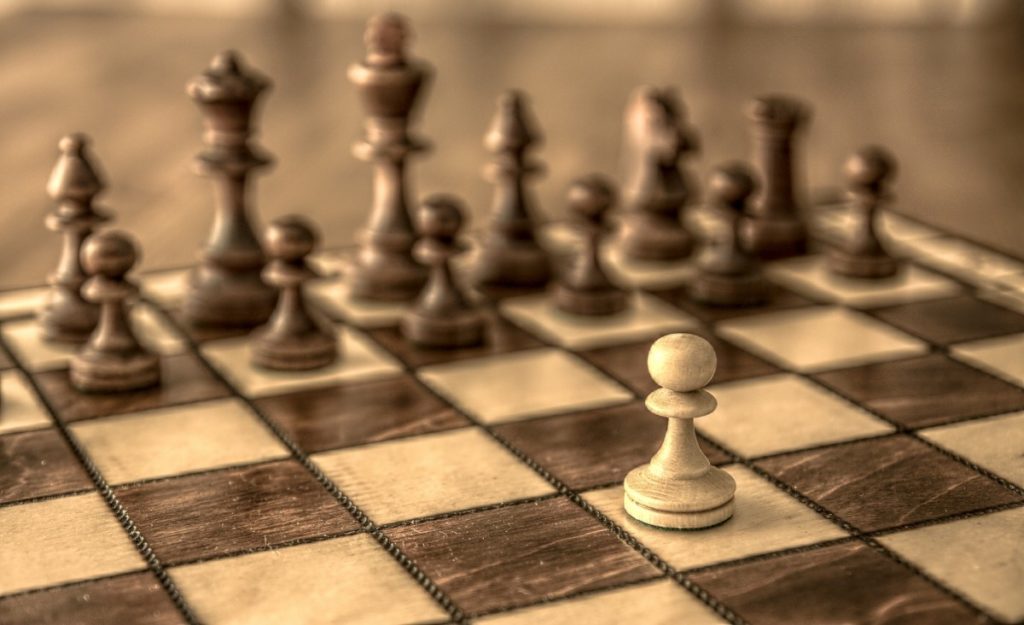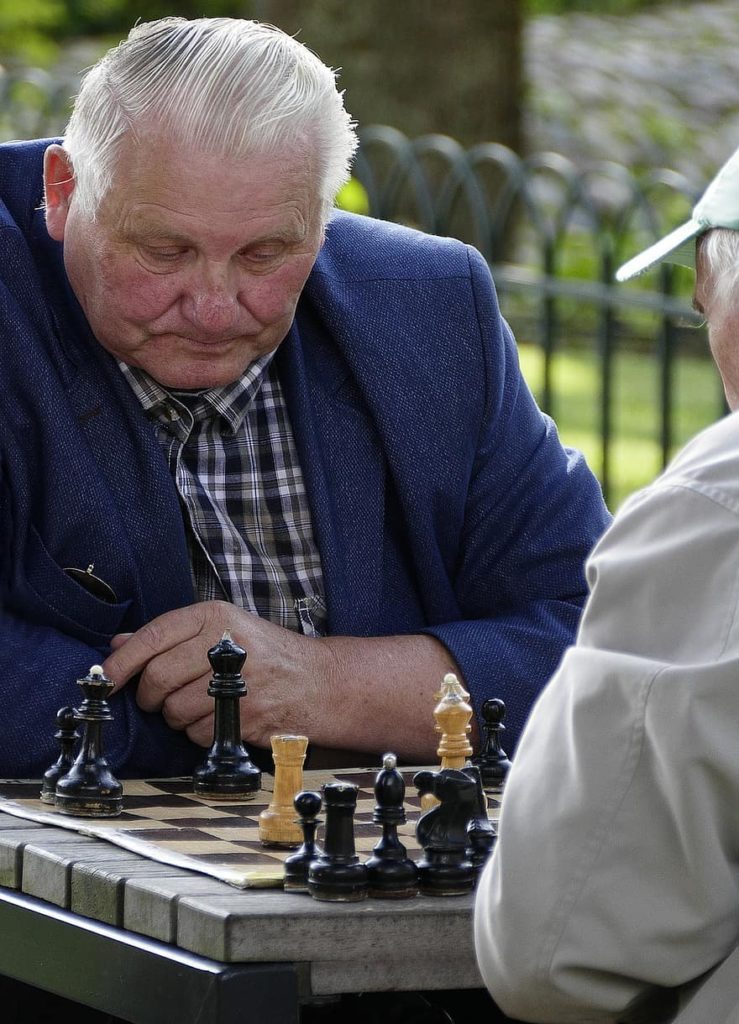The Dutch & Chess – Part 2: Chess Vocabulary Posted by Sten on Dec 10, 2020 in Culture, Dutch Language, Dutch Vocabulary
With the miniseries The Queen’s Gambit, schaken (to play chess) has received a lot of attention. When I was a kid, I played schaak (chess) competitively with a Dutch schaakvereniging (chess club). I was never that good, let alone at Beth Harmon’s level, but I had my fun and victories. I could really identify with the long and exhausting games that could last 4 hours or more. With the accurate depiction of schaak, based on real partijen (parties) played between legendary spelers (players), it is a wonderful homage to the game. So I decided that I would do my own little miniseries on schaak in the Netherlands. In this three-parter, I will look at the following questions: Did the Dutch ever have a wereldkampioen (world champion)? How does chess vocabulary translate to Dutch? And what if you wanted to get started playing chess in the Netherlands yourself? Today, we’ll take a look at some chess vocabulary, as there is quite some proprietary stuff going on.
For other posts in this miniseries, click here.
Voor het spel
The first things to know are, of course, the names of the pieces and how the chess board works. Here’s a list:
| wit | white |
| zwart | black |
| de koning | the king |
| de dame, koningin | the queen |
| de loper | the bishop |
| het paard | the knight |
| de toren | the rook |
| de pion | the pawn |
| het schaakbord, het bord | the chess board, the board |
| het veld | the square |
| de lijn | the file (vertical lines) |
| de rij | the rank (horizontal rows) |
| de diagonaal | the diagonal |
| het centrum | the center (the center four squares on the board) |
| de koningsvleugel | the kingside (the king’s side of the board) |
| de damevleugel | the queenside (the queen’s side of the board) |
| noteren | to notate (chess moves) |
| de notatie | the notation |
| de klok | the clock |
| vluggertje | quickie (quick game of 5 minutes for each player) |
| de simultaan | the simultaneous (when one player plays multiple other players at the same time) |
| de rating | the rating (rating assigned to a player estimating their strength) |
| aangeraakt is zetten | touch-move rule (if you touched a piece, you have to move it. unless you say “j’adoube” before touching the piece to put it properly back into its square, for example) |
With these basics, you get an idea of the names of each of the pieces, the board and what to call some chess situations. Let’s start playing!
De opening
| de opening | the opening |
| de zet | the move |
| ontwikkelen | to develop |
| aanvallen | to attack (a piece) |
| dekken | to defend, to protect (a piece) |
| rokeren | to castle (moving the king two squares towards the rook and placing the rook on the square on the other side of the king) |
| rokade | castling |
| het damesgambiet | the queen’s gambit |
| herdersmat | scholar’s mate (a checkmate that happens after 4 moves. because it is easily seen and averted, it is really only played by a beginner against a beginner) |
The opening has a few words related to it. It is the time that you make your first zetten to conquer het centrum and to ontwikkelen your stukken. Ideally, you can rokeren, while dekken your stukken and not losing them. While e4, moving the koningspion (king’s pawn) two squares up, is a common opening, the damesgambiet, where you use the damespion (queen’s pawn) and after zwart plays the same move, you play c4 and offer your pion for a better stelling. What you want to avoid at all costs is the herdersmat! Here’s how you can avoid it:
Het middenspel
| het middenspel | the middlegame |
| de positie, de stelling | the position |
| schaak! | check! |
| schaak staan | to be in check |
| (een stuk) slaan | to capture (a piece) |
| ruilen | to exchange |
| hout | material (“wood”) |
| voordeel | advantage |
| de penning | the pin (when a piece can’t move because it would put the king in check or because it would expose a stronger piece to being captured) |
| de vork | the fork (where a piece, mostly a knight, attacks two pieces at once, creating a fork-like shape) |
| het offer | the sacrifice (sacrificing a piece for advantageous position, checkmate or potential for winning material) |
| de dubbelpion | the doubled pawns (when two pawns end up on the same file) |
During the middenspel, it is time to push your opponent, finding opportunities and holes in their opening stelling. Can you get them to lose a pion, can you gain any voordeel or hout anywhere? Or perhaps you can simply gain a better stelling by moving your pieces in more active positions? Maybe you’re ingenious and can find a way to make an offer in exchange for a winning position, finding your own immortal game! What you want to avoid here are dubbelpionnen, as these are quite useless and vulnerable most of the time. Also penningen and vorken can be quite painful, as they make it difficult to maneuver into a better position or make you lose hout! Maybe you just really want to get to the eindspel, and you decide to ruilen as many stukken as you can, hoping to slaan a pion here and there to gain an advantage in the eindspel.
Het eindspel
| het eindspel | the endgame |
| de promotie | the promotion (when a pawn reaches the last rank and is promoted to a “higher” piece, such as a queen) |
| verloren stelling | lost position |
| eeuwig schaak | perpetual check (when one player forces the other player to repeat a pattern of check that leads to an automatic draw after repeating threefold) |
| schaakmat | checkmate |
| mat-achter-de-paaltjes | back-rank checkmate/corridor checkmate (“mate behind the poles”) (where a rook or queen mates the king on the last rank behind its own three pawns) |
| stikmat | smothered mate (mate by the knight where the king is unable to move because it is surrounded, or smothered, by his own pieces) |
| pat | stalemate |
| remise | draw |
| opgeven | to resign |
| de tijdnood | the time trouble/pressure |
| goed gespeeld! | good game |
| sportief | sportsmanlike |
You ruilde enough stukken to make it into the eindspel. Both you and your opponent still have a dame and some pionnen. But how do you now get a win? Will you be able to push a pion for its promotie? Perhaps there are still enough pieces for a stikmat or a mat-achter-de-paaltjes, very sneaky, that last one, and sometimes easily overlooked. Maybe your position is worse than you expected it to be after the middenspel and you have a verloren stelling. Or perhaps you are in tijdnood and don’t have enough tijd to find the winning zetten. Your best bet then is to get a remise. One way to get there is with pat or eeuwig schaak. Or will you simply opgeven? No matter what, it’s only sportief to give your opponent a hand (depending on COVID) and tell them: goed gespeeld!
For more Dutch vocabulary on chess, check out this website.
How ‘s your schaakspel? What’s your favorite act of the game? Did this vocabulary help you, or is there some missing? Let me know in the comments below!
See you on Monday for Part 3 – how to get started playing chess in the Netherlands!

Build vocabulary, practice pronunciation, and more with Transparent Language Online. Available anytime, anywhere, on any device.







